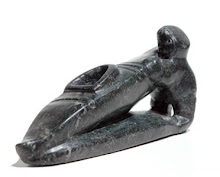As, I guess, has happened to all first-time qajaq builders before, I found it pleasantly surprising how, all of a sudden, two long planks of wood suddently start looking boat-like when put on the forms.
Moreover, I did the string thingy to check for simmetry and alignment and I found I was within Cunningham's "terrific job" range. I wouldn't have taken any bets on that.
Not that everything went perfectly well and smooth, of course. The MDF forms did give some problems. Midly gloomy predictions by master craftsman Xevi (check his blogs, the qajaq, the umiaq and... well the other things... Very much worth it) tended to come true. A couple of the middle forms had one of their external arms broken and the bow and stern forms did tend to spread at the top (next ones, if there are next ones, will not be open in the middle).
Fortunately, friend and fellow builder Alfonso (whose qajaq and paddle building blog I also recommend heartily) had brought to my attention the contraption in the picture below when my project was little more than worries and a long list of potential problems in my mind and how to deal with a changing gunwale flare was prominent among them. It is basically two pieces of wood joined on top and bottom by Spanish windlasses, thus allowing for separate adjustment of pressure on the gunwale's upper and lower edge.
It looks like it was inspired by (or provided itself the inspiration for) some instrument of torture, but, in any case, the thing has worked very well in persuading the gunwales to take the desired, varying angles. I really like it. If there are more qajaqs in the future, I think I'll go with simpler, sturdier forms coupled with this thing. Thank you, Alfonso.
The tendency to open of the end forms was cured using cam buckle straps around them. The straps also proved generally useful to help hold the overall shape. Oh, I also did the kerf cutting magic so the gunwales' ends make proper contact. And started cutting and adjusting the first straight deck beam (rasps and files, what a great invention...).
So, there is progress. I have something I can look at and think of a qajaq and I have learned for the future.
I have almost forgotten the moments of panic by now.

